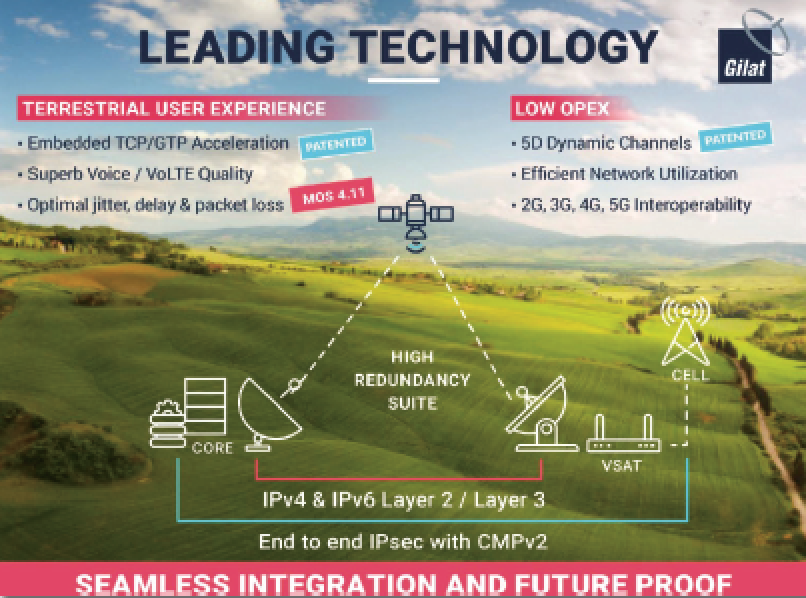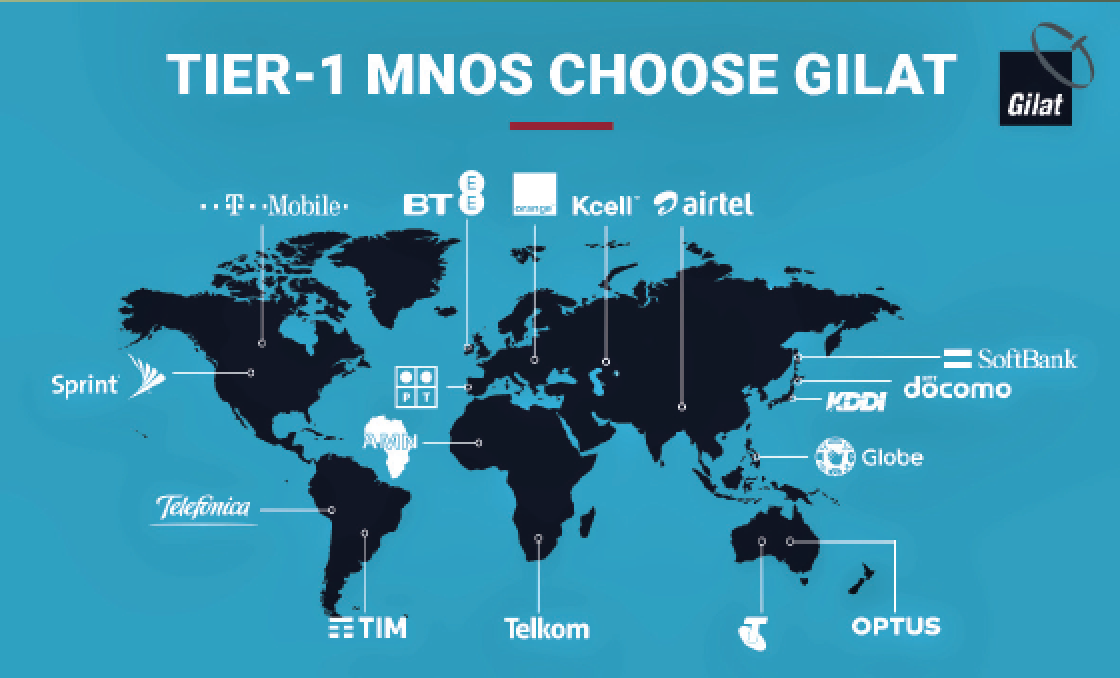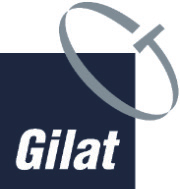Gilat Holds More Than 80 Percent Market-Share Of Satellite 4G CBH Market
Both the economics, as well as overcoming technical challenges, have brought 4G/LTE satellite backhauling to the forefront in the more established markets as well as in the developing world. Clearly, the traditional markets of Asia, Africa, and Latin America are prime candidates for connectivity due to their lack of terrestrial infrastructure. However, at Gilat, we see significant growth and need in the developed world, including North America, Japan and Australia.

Gilat’s achievement of holding more than 80 percent market- share in satellite backhaul for 4G/LTE installations worldwide, is due to both technological capabilities as well as global expertise, local presence, outstanding support and superior delivery capabilities.
The use cases vary greatly and have changed worldwide over the years to serve a variety of applications such as emergency response and Internet of Things (IoT). In addition, today’s applications require high throughput just as much for upload, as well as for download. End-users want to share data such as videos and photos over social media, shifting from a download centric traffic profile to a growing need for data upload. To meet these needs, Gilat is continually evolving its VSATs to address the changing requirements.
Tier-1 MNOs worldwide have implemented Gilat’s solution.
Some examples include:
In the US: TMobile and Sprint
In the UK: BT/EE
In Australia: Telstra and Optus
In the Philippines: Globe Telecom
In South America: Telefonica and TIM
In Japan: Gilat dominates the satellite backhaul market with
Softbank, NTT Docomo and KDDI, among others.
In all of these situations, and more, satellite backhauling is a quick solution that can be deployed anywhere. In many circumstances the costs and time involved in setting up a terrestrial infrastructure, if even feasible, would not be cost effective.
Extending cellular networks outside of crowded urban areas is the primary reason for MNOs to adopt a satellite backhaul solution. At times the requirement comes from the government that is looking to include the rural population in the country’s economy, with a sincere desire to narrow the digital divide. Often in these cases, it is mandatory for the mobile operator to supply such connectivity to the underserved or unserved areas. At other times, competition between MNOs in increasing their subscriber base drives MNOs to extend networks, so as not to be required to pay roaming costs to a competitor when their subscriber moves out of their current coverage area. In other cases, there are areas where an opportunity arises to support tourist attractions such as hiking trails, scenic travel routes and ski resorts, that require connectivity.
Another example of a CBH application is within the agriculture Internet of Things (IoT) business. As an example, Gilat provides 4G services to TIM Brasil’s IoT agribusiness from the coastline into the country. Gilat’s 4G network expansion allows to connect machines and operators to real-time control and monitoring of harvesters and agricultural tractors.
This enables cost-effective decisions, and quick and effective crop management and further productivity in the production flow. Finally, likely the fastest growing application for cellular backhaul is for emergency response and backup. Satellite backhauling is the solution of choice when terrestrial infrastructures collapse. In the next section this topic is further discussed.

Emergency Response & Backup — A Growing Application
Whether dealing with a natural disaster or a terrorist attack, reliable communications and access to information are critical for enabling effective emergency response. Climate change and its impact on natural disasters are causing MNOs and regulators to rethink their emergency preparedness and emergency response strategies.
To meet the public’s ever-growing reliance on mobile communications, there is a growing interest in broadband communication that is not dependent on the risk-prone terrestrial infrastructure. Therefore, we are seeing more local governments, MNOs and emergency organizations adopting alternative solutions, such as satellite communications, for emergency response and disaster recovery.
Independent from terrestrial and wireless infrastructure, satellite communications provide a secure and reliable solution that can be deployed quickly for disaster response or national emergencies. CBH over satellite solutions enables MNOs to extend network coverage to remote areas beyond the reach of terrestrial infrastructure, enabling emergency services to operate seamlessly in virtually any location. In other cases, satellite backhaul can serve as a backup solution should the terrestrial network go offline due to a disaster or malfunction. This means that precisely when communication is most important for saving lives, it is all-too-often not available due to network breakdown.
When lives are on the line and every second counts, first responders require advanced technologies that can be rapidly deployed anywhere to support voice, video and data applications. Satellite backhauling is the technology that supports effective real-time communications and continuous situational awareness, as they are citical for making high-pressure decisions in the toughest imaginable circumstances.
Gilat is involved in numerous real-world emergency response and backup deployments. A particularly massive implementation is going on in the UK with EE/BT, one of Europe’s largest 4G networks. EE/BT is working with Gilat to build out the world’s largest 4G Emergency Services Network (ESN) to provide network resilience and backup for the UK population.
EE/BT was commissioned by the UK’s Home Office to deliver emergency service coverage for the entirety of the UK over their 4G nationwide network. The ESN runs over EE/BT’s commercial network, which automatically grants priority use to emergency services. EE/BT is using Gilat’s field-proven cellular backhaul solution to extend ESN’s coverage to remote areas without terrestrial infrastructure, enabling emergency services to operate seamlessly in any location throughout the UK. Moreover, Gilat is in the process of deploying about 1,000 LTE satellite backhaul sites, including weather-proof VSATs in outdoor locations. These sites will enable service in areas without terrestrial infrastructure or in other cases serving as a backup solution.
The ESN enables network resilience in the event of a cell site failure, as well as providing immediate high-speed voice and data connectivity to emergency response teams in the field. Gilat’s Capricorn VSAT answered the requirement of delivering true LTE speeds to 4G handsets and fully supporting encrypted data. The ESN deployment comprises of both fixed and portable on-the-pause cell sites, which use a vehicle-mounted solution containing both the cell node and the Gilat VSAT that handles the backhaul.
5G: The Future is Knocking on the Door
As the world moves into the future, there is no doubt that satellite communication is essential to materialize the upcoming technologies such as 5G. The 5G vision, of ubiquitous connectivity, is dependent on satellite backhauling as an essential enabler to provide the scale and scope for connectivity everywhere. Gilat is making significant headway in the evolving 5G ecosystem that will directly influence the way people live and work.
Gilat has proven in numerous demonstrations that the company’s SkyEdge II-c platform is 5G ready. As an example, a recent demonstration of carrying 5G traffic with outstanding performance took place in Thailand over Thaicom’s IPSTAR GEO HTS Satellite.
These tests with 5G handsets, demonstrated unique speeds, of 400 Mbps download and 100 Mbps upload, while running a large number of applications including: Browsing, Speedtest, Youtube 4K, VoLTE, ViLTE, Virtual Reality, Augmented Reality and even communication with a drone providing a live video stream. The tests were completed with several 5G architecture options, including Standalone (SA) and Non-Standalone (NSA), using Gilat’s Capricorn PLUS VSAT with the adaptation of its patented GTP acceleration.
As the requirement for coverage anywhere/anytime continues to expand, the technology roadmap must keep in synch, thus demanding more bandwidth at higher speeds and lower latency. In addition, the technology roadmap must support technologies that will reduce cost and complexity to ensure the most efficient solution.
As such, Gilat recently launched the next generation family of VSATs, Aquarius, supporting 5G Networks in both GEO and NGSO constellations. Gilat’s Aquarius family of ultra-high-performance, multi-orbit VSATs provides more than 2 Gbps of concurrent speeds and supports seamless satellite handover.
As 5G networks are deployed and customer demands continue to exponentially grow, Gilat’s Aquarius VSATs are designed to serve, with maximum efficiency, data and media intensive applications. This new family of VSATs is designed to provide uninterrupted service, ultra-high-performance and support for next generation software defined satellite constellations. Further, the high-throughput with a Multi Access Edge Computing (MEC) infrastructure, enables deployment and orchestration of 3rd party virtualized network functions on the VSAT, simplifying remote site management and operations for next generation 5G services, such as video caching and IoT gateways. These and other Aquarius VSAT capabilities, coupled with Gilat’s longtime experience and patented cellular backhaul technology,
make it the solution of choice for enabling MNOs to deliver their customers a true 5G experience over satellite.
5G adoption is expected initially in the cities, which will drive additional 4G over satellite deployments into suburban and rural areas, where terrestrial coverage is less feasible. At a second stage, 5G deployment over satellite will spread to rural areas, as well, answering the promise of universal coverage. Gilat with its 80% market share in 4G/LTE satellite backhauling is continuing to address the 4G market and is more than ready to answer the 5G challenge.
The unique attributes of satellite communication and its proven value in numerous applications make it an essential component of cellular networks to enable reach to people wherever they are, thus supporting the narrowing of the digital divide. Furthermore, the dropping prices of satellite capacity are making satellite communication the feasible solution to solve today’s communication needs.

Not only does satellite enable connecting remote locations, it strengthens the resiliency of communications networks, and directly contributes to saving lives. Gilat has proven its superior satellite backhauling technology worldwide and is diligently at work for next generation solutions to meet the challenges still ahead.
www.gilat.com/solution/cellular-backhaul/

Author Doreet Oren (doreeto@gilat.com) is Director of Product Marketing & Corporate Communications for Gilat Satellite Networks. Doreet Oren has been in this role since 2012 and has been responsible for defining product positioning, messaging, go-to- market strategies, market research, and analyst relations.
Oren has more than 20 years of industry experience, and has held management positions in R&D, product management and product marketing, for international high-tech companies. In this capacity she contributed to next generation product definition and was responsible for delivering the company’s vision to the media and analyst community.
Doreet has published thought leadership articles in renowned international journals, and has spoken at numerous industry conferences worldwide. Oren received a BSc in Computer Science from George Washington University.


